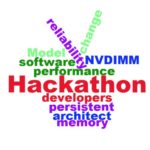It’s very rare that there is a significant change in computer architecture, especially one that is nearly immediately pervasive across the breadth of a market segment. It’s even more rare when a fundamental change such as this is supported in a way that software developers can quickly adapt to existing software architecture. Most significant transitions require a  ground-up rethink to achieve performance or reliability gains, and the cost-benefit analysis generally pushes a transition to the new thing be measured in multiple revisions as opposed to one, big jump.
ground-up rethink to achieve performance or reliability gains, and the cost-benefit analysis generally pushes a transition to the new thing be measured in multiple revisions as opposed to one, big jump.
In the last decade the growth of persistent memory has bucked this trend. The introduction of the solid-state disk made an immediate impact on existing software, especially in the server market. Any program that relied on multiple, small-data, read/write cycles to disk recognized significant performance increases. In cases such as multi-tiered databases, the software found a, “new tier,” of storage nearly automatically and started partitioning data to it. In an industry where innovation takes years, improvement took a matter of months to proliferate across new deployments.
While the SSD is now a standard consideration there is unexplored opportunity in solid-state storage. The NVDIMM form factor has been in existence for quite some time, providing data persistence significantly closer to processing units in the modern server and workstation. Many developers, however, are not aware that programming models already exist to easily incorporate some simple performance and reliability, both for byte and block access in programs. Moreover, new innovations of persistent memory are on the horizon that will increase the density and performance of DIMM form factors.
Perhaps it’s time that more software architecture should be working on adapting this exciting technology. The barriers to innovation are very low, and opportunity is significant. Over the year 2019, SNIA will be sponsoring the delivery of several workshops dedicated to opening up persistent memory programming to the developer community. The first of these will be a Persistent Memory Programming Hackathon at the Hyatt Regency Santa Clara CA on January 23, 2019, the day before the SNIA Persistent Memory Summit. Developers will have the opportunity to work with experienced software architects to understand how to quickly adapt code to use new persistent memory modes in a hackathon format. Learn more and register at this link.
Don’t miss the opportunity to move on a strategic software inflection point ahead of the competition. Consider attending the 2019 SNIA Persistent Memory Summit and exploring the opportunity with persistent memory.